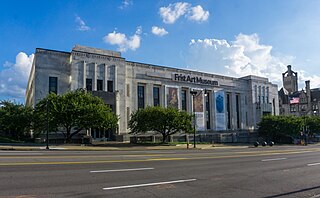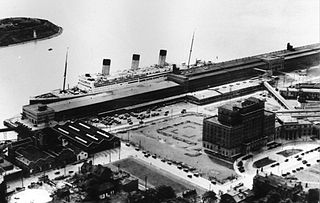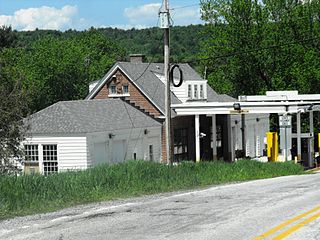
Ellis Island is a federally owned island in New York Harbor, situated within the U.S. states of New York and New Jersey, that was the busiest immigrant inspection and processing station in the United States. From 1892 to 1954, nearly 12 million immigrants arriving at the Port of New York and New Jersey were processed there under federal law. Today, it is part of the Statue of Liberty National Monument and is accessible to the public only by ferry. The north side of the island is the site of the main building, now a national museum of immigration. The south side of the island, including the Ellis Island Immigrant Hospital, is open to the public only through guided tours.

The United States Immigration and Naturalization Service (INS) was an agency of the U.S. Department of Labor from 1933 to 1940 and the U.S. Department of Justice from 1940 to 2003.
The U.S. Immigration and Customs Enforcement (ICE) is a federal law enforcement agency under the U.S. Department of Homeland Security. ICE's stated mission is to protect the United States from the cross-border crime and illegal immigration that threaten national security and public safety.

The Chinatown–International District of Seattle, Washington is the center of Seattle's Asian American community. Within the Chinatown International District are the three neighborhoods known as Seattle's Chinatown, Japantown and Little Saigon, named for the concentration of businesses owned by people of Chinese, Japanese and Vietnamese descent, respectively. The geographic area also once included Seattle's Manilatown. The name Chinatown/International District was established by City Ordinance 119297 in 1999 as a result of the three neighborhoods' work and consensus on the Seattle Chinatown International District Urban Village Strategic Plan submitted to the City Council in December 1998. Like many other areas of Seattle, the neighborhood is multiethnic, but the majority of its residents are of Chinese ethnicity. It is one of eight historic neighborhoods recognized by the City of Seattle. CID has a mix of residences and businesses and is a tourist attraction for its ethnic Asian businesses and landmarks.

The Frist Art Museum, formerly known as the Frist Center for the Visual Arts, is an art exhibition hall in Nashville, Tennessee, housed in the city's historic U.S. Post Office building, which is listed on the National Register of Historic Places.
Immigration detention is the policy of holding individuals suspected of visa violations, illegal entry or unauthorized arrival, as well as those subject to deportation and removal until a decision is made by immigration authorities to grant a visa and release them into the community, or to repatriate them to their country of departure. Mandatory detention refers to the practice of compulsorily detaining or imprisoning people seeking political asylum, or who are considered to be illegal immigrants or unauthorized arrivals into a country. Some countries have set a maximum period of detention, while others permit indefinite detention.

Pier 21 was an ocean liner terminal and immigration shed from 1928 to 1971 in Halifax, Nova Scotia, Canada. Nearly one million immigrants came to Canada through Pier 21, and it is the last surviving seaport immigration facility in Canada. The facility is often compared to the landmark American immigration gateway Ellis Island. The former immigration facility is now occupied by the Canadian Museum of Immigration, the Nova Scotia College of Art and Design as well as various retail and studio tenants.
U.S. Citizenship and Immigration Services (USCIS) is an agency of the United States Department of Homeland Security (DHS) that administers the country's naturalization and immigration system. It is a successor to the Immigration and Naturalization Service (INS), which was dissolved by the Homeland Security Act of 2002 and replaced by three components within the DHS: USCIS, Immigration and Customs Enforcement (ICE), and Customs and Border Protection (CBP).

The GEO Group, Inc. (GEO) is a publicly traded C corporation that invests in private prisons and mental health facilities in North America, Australia, South Africa, and the United Kingdom. Headquartered in Boca Raton, Florida, the company's facilities include illegal immigration detention centers, minimum security detention centers, and mental-health and residential-treatment facilities. It also operates government-owned facilities pursuant to management contracts. As of December 31, 2021, the company managed and/or owned 86,000 beds at 106 facilities. In 2019, agencies of the federal government of the United States generated 53% of the company's revenues. Up until 2021 the company was designated as a real estate investment trust, at which time the board of directors elected to reclassify as a C corporation under the stated goal of reducing the company's debt.

Angel Island Immigration Station was an immigration station in San Francisco Bay which operated from January 21, 1910 to November 5, 1940, where immigrants entering the United States were detained and interrogated. Angel Island is an island in San Francisco Bay. It is currently a State Park administered by California State Parks and a California Historical Landmark. The island was originally a fishing and hunting site for Coastal Miwok Indians, then it was a haven for Spanish explorer Juan Manuel de Ayala. Later, it was developed as a cattle ranch, then, starting with the Civil War, the island served as a U.S. Army post. During the island's Immigration Station period, the island held hundreds of thousands of immigrants, the majority from China, Japan, India, Mexico and the Philippines. The detention facility was considered ideal because of its isolated location, making it very easy to control immigrants, contain outbreaks of disease, and enforce the new immigration laws. The station is listed on the National Register of Historic Places under the title Angel Island, U.S. Immigration Station, and is a National Historic Landmark. The station is open to the public as a museum – "a place for reflection and discovery of our shared history as a nation of immigrants".
Reno v. Flores, 507 U.S. 292 (1993), was a Supreme Court of the United States case that addressed the detention and release of unaccompanied minors.

The United States government holds tens of thousands of immigrants in detention under the control of Customs and Border Protection and the Immigration and Customs Enforcement (ICE). Immigrants are detained for unlawful entry to the United States, when their claims for asylum are received, and in the process of deportation and removal from the country. During Fiscal Year 2018, 396,448 people were booked into ICE custody: 242,778 of whom were detained by CBP and 153,670 by ICE's own enforcement operations. A daily average of 42,188 immigrants were held by ICE in that year. In addition, over twelve thousand immigrant children are housed by facilities under the supervision of the Office of Refugee Resettlement's program for Unaccompanied Alien Children. Prior to referral to these other agencies, the CBP holds immigrants at processing centers; between mid-May and mid-June 2019, it held between 14,000 and 18,000 immigrants.

Washington Hall is a historic building and a registered city landmark in Seattle, Washington, that is listed on the National Register of Historic Places. It was originally built as a community center by the Danish Brotherhood in America, a fraternal organization, with meeting halls and one-room apartments for new immigrants. In 1973, the building was sold to the Sons of Haiti who leased the space to various tenants. It was purchased in 2009 by Historic Seattle and was renovated and re-opened in 2010.

The Ellis Island Immigrant Hospital was a United States Public Health Service hospital on Ellis Island, in New York Harbor, that operated from 1902 to 1951. The hospital is part of the Statue of Liberty National Monument. While the monument is managed by the National Park Service as part of the National Parks of New York Harbor office, the south side of Ellis Island, including the hospital, is managed by the non-profit Save Ellis Island Foundation and has been off-limits to the general public since its closing in 1954.

The West Berkshire–Frelighsburg Border Crossing connects the town of Frelighsburg, Quebec with the western portion of Berkshire, Vermont on the Canada–United States border. It is reached by Vermont Route 108 on the American side and by Quebec Route 237 on the Canadian side.

The Richford–Abercorn Border Crossing connects the town of Abercorn, Quebec with the town of Richford, Vermont on the Canada–US border. It is located at the meeting point of Quebec Route 139 and Vermont Route 139, roughly midway between the two village centers. A United States border station has existed here since at least 1926; the present 1935 station was listed on the US National Register of Historic Places in 2014. Both stations are open 24 hours per day, seven days per week.
Family detention is the detention of multiple family members together in an immigration detention context. In the U.S. they are referred to as family detention camps,family detention centers, or family detention facilities.

The German House also known as the Assay Office and Prosch Hall is a building in the First Hill area of Seattle, Washington, which since its construction in 1893 has variously functioned as an office block, an entertainment hall and, until 1932, the city's assay office through which most of the gold brought to Seattle from the Yukon gold rush was processed into bricks. Following World War II the building returned to the possession of its previous German-American owners; it continues today to be a popular venue for German-themed events in Seattle. It was designated a Seattle Landmark in 1983. It was listed on the National Register of Historic Places as Assay Office in 1972.

The Columbia River Quarantine Station, now known as the Knappton Cove Heritage Center, is a historic site in Knappton, Washington. The station provided fumigation and quarantine services to maritime vessels at the port on the Columbia River from 1899 to 1938, and is the sole remaining quarantine station on the West Coast of the United States as all others were burned for fear of contamination. It was added to the National Register of Historic Places in 1980.
Berks County Residential Center (BCRC), also known as Berks Family Residential Center and as the Berks County detention center, is a 96-bed immigration detention center in Leesport, Berks County, Pennsylvania, operated by Berks County on contract with U.S. Immigration and Customs Enforcement (ICE). The center operated as a family detention center from March 2001 to March 2021.
















